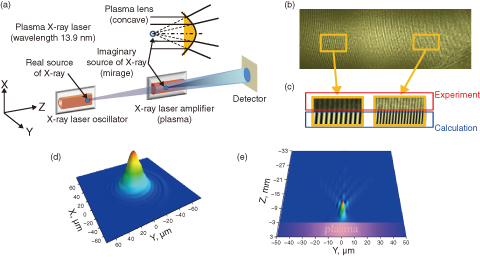
Fig.5-30
Mirages are well-known phenomena aroused in the Earth’s atmosphere. They result from the uncontrolled deflection of light rays from rectilinear propagation in inhomogeneous media. Mirages in the X-ray range have been considered extremely difficult to form because the refractive indices of conventional materials to X-rays are close to unity, which essentially excludes refraction.
JAEA has developed plasma X-ray lasers with excellent narrow beam divergence. We injected these X-ray laser beams into a plasma that amplifies X-rays of the same wavelength (Fig.5-30(a)), and obtained a coaxial interference pattern (Fig.5-30(b)). Coaxial interference patterns are generated if two coherent X-ray sources are positioned on the same straight line from the observation point. To explain the observed phenomena, we considered that the plasma behaves as an inhomogeneous atmosphere, i.e., a portion of the X-ray laser beam is refracted and expanded by a concave lens effect in the plasma, forming an imaginary source that appears to exist at the lens focal point. Indeed, if the imaginary source is assumed to lie inside the plasma, the calculated and experimental fringe patterns are completely consistent (Fig.5-30(c)). Considering its similarity to ordinary mirage formation, we conclude that we have generated the first example of an X-ray mirage.
To visualize the imaginary source (the X-ray mirage) on the basis of the experimental result, we have developed a theoretical calculation code, accounting for X-ray refraction and amplification in the plasma. The simulated spatial profiles of the imaginary source are presented in Figs.5-30(d) and (e). The formation of an X-ray mirage was found to strongly depend on the amplification effects of the plasma.
The X-ray mirage discovered in the present study may be adopted in novel plasma-based X-ray optics and methods for diagnosing plasmas, providing useful information of the density profiles, amplification effects, and other properties of plasmas.
The present study was partly supported by Japan Society for the Promotion of Science (JSPS) KAKENHI Grant-in-Aid for Scientific Research (B) (No.25289244).